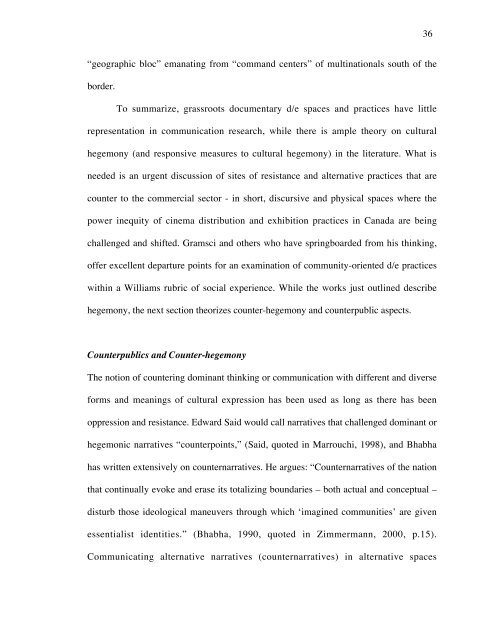The Spaces Between Grassroots Documentary ... - Ezra Winton
The Spaces Between Grassroots Documentary ... - Ezra Winton
The Spaces Between Grassroots Documentary ... - Ezra Winton
Create successful ePaper yourself
Turn your PDF publications into a flip-book with our unique Google optimized e-Paper software.
“geographic bloc” emanating from “command centers” of multinationals south of the<br />
border.<br />
To summarize, grassroots documentary d/e spaces and practices have little<br />
representation in communication research, while there is ample theory on cultural<br />
hegemony (and responsive measures to cultural hegemony) in the literature. What is<br />
needed is an urgent discussion of sites of resistance and alternative practices that are<br />
counter to the commercial sector - in short, discursive and physical spaces where the<br />
power inequity of cinema distribution and exhibition practices in Canada are being<br />
challenged and shifted. Gramsci and others who have springboarded from his thinking,<br />
offer excellent departure points for an examination of community-oriented d/e practices<br />
within a Williams rubric of social experience. While the works just outlined describe<br />
hegemony, the next section theorizes counter-hegemony and counterpublic aspects.<br />
Counterpublics and Counter-hegemony<br />
<strong>The</strong> notion of countering dominant thinking or communication with different and diverse<br />
forms and meanings of cultural expression has been used as long as there has been<br />
oppression and resistance. Edward Said would call narratives that challenged dominant or<br />
hegemonic narratives “counterpoints,” (Said, quoted in Marrouchi, 1998), and Bhabha<br />
has written extensively on counternarratives. He argues: “Counternarratives of the nation<br />
that continually evoke and erase its totalizing boundaries – both actual and conceptual –<br />
disturb those ideological maneuvers through which ‘imagined communities’ are given<br />
essentialist identities.” (Bhabha, 1990, quoted in Zimmermann, 2000, p.15).<br />
Communicating alternative narratives (counternarratives) in alternative spaces<br />
36


